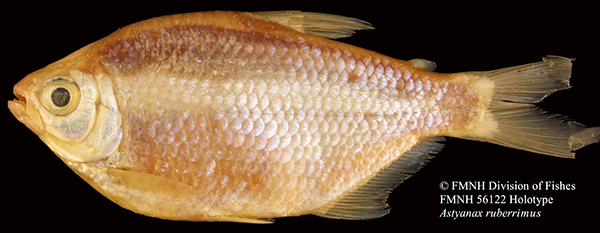Characidae - Astyanax ruberrimus Eigenmann, 1913 |
 |
| Photograph of holotype collected from Istmina, Colombia. |
| SOURCE FOR OCCURRENCE IN ECUADOR: Barriga (2012), Jimenez et al. (2015). |
| ORIGINAL DESCRIPTION: Eigenmann, C.H. 1913. Some results from an ichthyological reconnaissance of Colombia, South America. Part II. Contrib. Zool. Lab. Ind. Univ. No. 131. Indiana University Studies No. 18: 1-32. |
| TYPE SPECIMENS: FMNH-56122. |
| TAXONOMIC STATUS: Unclear. May possibly include a complex of multiple species in northwestern Ecuador (Pedro Jimenez-Prado, personal communication) or may be a synonym of another species from Colombia or Central America. Much more taxonomic work is needed on the characids in the genera Astyanax and Bryconamericus in western Ecuador. |
| RANGE ECUADOR: This species occurs in northwestern Ecuador in the Esmeraldas and Santiago-Cayapas drainages, as well as in some of the smaller nearby drainages including the Atacames, Sua, and Mompiche drainages (Jimenez-Prado et al., 2015). |
| RANGE OUTSIDE OF ECUADOR: The holotype for this species is from the San Juan River in the Choco region of Colombia. It has also been recorded from the Atrato, Baudo, Anchicaya, Dagua, Patia and Jurado rivers in Colombia (Maldonado-Ocampo et al., 2012). |
| COLLECTIONS IN ECUADOR: |
| MAXIMUM SIZE: Reported to 150 mm total length in Ecuador, common to 70 mm TL (Jimenez-Prado et al., 2015). |
| DISTINGUISHING FEATURES: Differs from similar species in the genera Astyanax and Bryconamericus because it has five teeth in the internal row of the premaxillary while A. festae and Bryconamericus spp. have only four teeth (Jimenez-Prado et al., 2015). In addition, the other recognized species of Astyanax in western Ecuador, A. festae, posseses two distinctive and well-pronounced black blotches in the anterior part of the body, while A. ruberrimus lacks these very distinctive marks. Astyanax ruberrimus has a complete lateral line with 38-39 scales with pores, and counts of ii,9 for the dorsal fin, iii,23-28 for the anal fin, i,12-13 for the pectoral fin, and i,7 for the pelvic fin (Jimenez-Prado et al., 2015). |
|
 |
| Comparison of the two species of Astyanax currently recognized in western Ecuador. Astyanax ruberrimus (left) and Astyanax festae (right). Astyanax ruberrimus occurs in northwestern Ecuador in drainages in Esmeraldas province while A. festae is common in southwestern Ecuador. Both species appear to occur in the Esmeraldas drainage (Windsor Aguirre, personal observation). |
|
| ECOLOGY: This species appears to be omnivorous, feeding on fruits and occasionally plant material, insects (especially beetles), and nematodes (Maldonado-Ocampo et al., 2012). It also appears to undergo seasonal upstream migrations at least in some rivers of Esmeraldas province. Jimenez-Prado et al. (2015) reprted observing a large-scale upstream migration of this species in the Atacames River in June and July of 2012. |
| ECONOMIC IMPORTANCE: Not of direct importance as a food fish because of its small size. People in rural areas do consume it fried where it is locally common (Jimenez-Prado et al., 2015). |
| CONSERVATION STATUS: This species appears to be locally common at low elevation sites in some rivers of Esmeraldas province like the Atacames, Sua, and Mompiche rivers (Jimenez-Prado et al., 2015), so it does not seem to be under immediate threat. However, Jimenez-Prado et al. (2015) report specimens with severe tumors in parts of the Santiago River drainage where mining is intense. Dam construction may also impede the upstream migrations observed by Jimenez-Prado et al. (2015), resulting in local ecological problems for this species. |
| LINK TO FISHBASE PAGE: Click here for link |
| SPECIES PROFILE CREATED BY: Windsor Aguirre |
| SPECIES PROFILE CONTRIBUTORS: NA |
|
|
|
|
|
